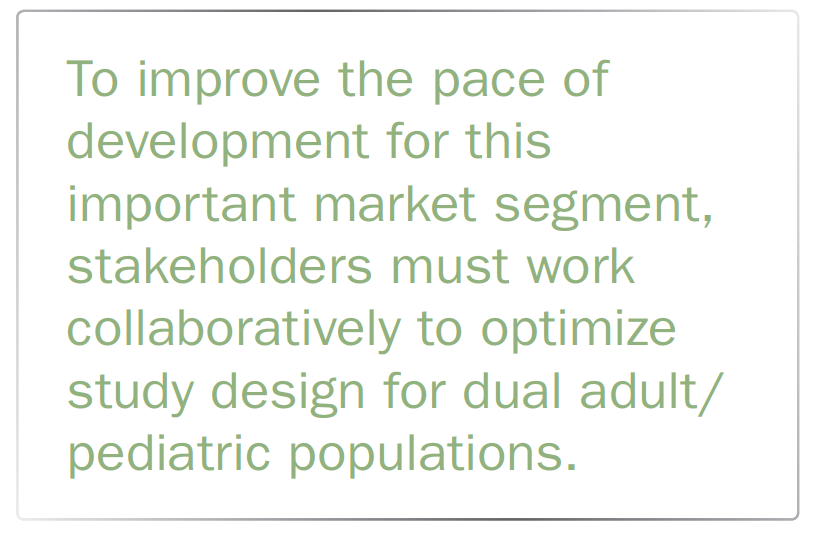A United Front for Better Pediatric Clinical Trials
Applied Clinical Trials
Forming strategic alliances and collaborating to optimize study design can significantly improve pediatric drug development.

Great opportunity exists for the research community to rally around the industry’s most precious patient population: children. The good news is that pediatric drug development is ripe for advancement.
In recent years, medical professionals have witnessed a significant change in the philosophical dynamics surrounding pediatric clinical trials. Instead of protecting children “from” research, industry efforts are now concentrated on protecting them “through” research. This shift has manifested itself in such U.S. legislation as the Pediatric Research Equity Act (PREA), which requires companies to assess the safety and effectiveness of new drugs/biologics in pediatric patients, and the Paediatric Regulation established by the European Union in 2007.
These drivers could open the door to new therapies that vastly improve long-term population health and quality of life. Yet, pediatric drug formulation, trial design, and dosage selection are characteristically complex, and many contract research organizations (CROs) lack specific expertise in designing clinical trials to serve younger populations.
To improve the pace of development for this important market segment, stakeholders must work collaboratively to

optimize study design for dual adult/pediatric populations, as well as promote patient enrollment plans that make the best use of limited resources. Forward momentum will rely heavily on strategic alliances that bring together the high-level expertise needed to address efficient clinical trial design, regulatory compliance, and protections for younger patients.
Understanding the nuances of pediatric drug development
Supply and demand are sizeable issues for pediatric clinical trials. Many children’s illnesses fall within the orphan disease category, impacting a small percentage of the population, often across a large geographic footprint. This characteristic alone illustrates the need for a broader patient recruitment reach within pediatric clinical trials.
CROs engaged in these studies often compete for the same patients, which is one reason why the FDA recently released new guidance to encourage greater collaboration that supports evaluation of multiple products in a single trial. While this move is a promising development, the current dynamic still poses significant challenges for many studies requiring a pool of young patients.
For example, studies that recruit from large geographic areas usually involve oversight from multiple regulators such as FDA and the European Medicines Agency (EMA). As such, CROs must ensure clinical trial design addresses the requirements of all governing bodies-a challenging proposition since pediatric requirements are continuously evolving and typically are not harmonized across borders. Often, trial design must follow the most stringent rules regardless of location to support clinical efficacy as well as standardized, operational efficiencies within a single plan.
Satisfying the need for operational consistency, quality, and data integrity throughout the clinical development process requires integrated, specialized global pediatric drug development resources able to leverage cutting-edge pediatric trial techniques-such as computer-based modeling and simulation-and optimal global clinical trials infrastructures. These nuances, coupled with the need for extra flexibility and safeguards for younger patients, often equate to greater risk in terms of cost and successful trial outcomes. For instance, 42% of recently completed pediatric trials failed to attain product labeling for use in children due to failure to establish safety or efficacy.
Fortunately, there is a better way.
Building a better pediatric clinical trial
The good news is that strategic industry alliances can reduce risk and improve the outlook for pediatric drug development. CROs that specialize in pediatric trials are partnering with global CROs that bring together the right combination of therapeutic expertise, trial design knowledge, and geographic reach to ensure efficient, effective operations across multi-population, multi-center, multi-national studies.

Every trial is unique, which means trial partnerships cannot take a one-size-fits-all approach to collaboration. However, such alliances can achieve success by creating cross-functional teams consisting of scientific, operational, and technical resources within both organizations, depending on the specific needs of the sponsor. A project manager from a global CRO, for example, might lead a blended team of pediatric pharmacokinetic/pharmacodynamic (PK/PD) and regulatory experts, with support from the global CRO’s trial monitoring and data management experts.
Collaborative efforts like these are exploring effective ways of minimizing the number of children needed for participation as well as their exposure to study elements such as medications and tests. A combination of advanced pharmacometric modeling and clinical trial simulation technologies-such as PK/PD modeling, physiologically-based PK (PBPK) modeling, and population PK analysis, for example-can help facilitate efficient pediatric trial design and minimize patient numbers and invasive procedures.
Often, economies of scale also can be achieved by drawing on the groundwork laid by late-state adult trials. The key is using the combined resources of global and pediatric CROs to get in front of adult trials to ensure considerations for pediatric research-including identifying data and formulation needs-are built into the initial design. A CRO specializing in pediatric clinical trials can bring pediatric formulation and juvenile toxicology expertise to the table, while a global CRO can incorporate its more extensive trial design knowledge.
Clinical trial design that considers both adult and pediatric populations produces numerous wins for sponsors. When adult clinical trials draw from their own data sets to support pediatric studies, the opportunities for reducing patient exposure, maximizing safety, and improving operational efficiencies increase exponentially. In addition, trial sponsors can leverage the benefits of incentive programs currently offered by the FDA and EMA. Organizations that are willing to embark on a pediatric clinical trial earn eligibility for a six-month exclusivity extension for both the adult and pediatric version of a product-a significant bottom-line consideration for certain products.
The industry is making notable strides to overcome barriers to, and speed the pace of, pediatric drug development. While the commercial opportunity is certainly improving, the reality is that the stakes are high in terms of medical need across all therapeutic areas. Children represent the industry’s most vulnerable and treasured patient population, so the value of greater collaboration and cooperation among stakeholders speaks for itself.
David Bowser is Executive Vice President and General Manager, Global Clinical Development, for Worldwide Clinical Trials; Martin A. Graham, PhD, is president and CEO of KinderPharm
